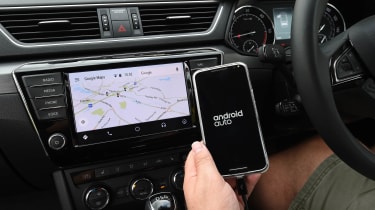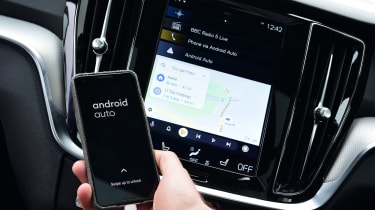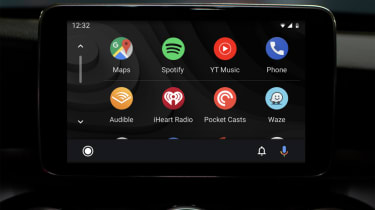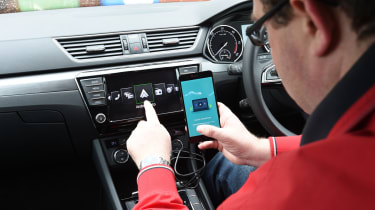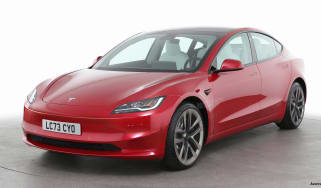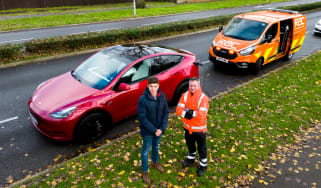What is Android Auto? Full review and user guide
What is Google's Android Auto and how does it enhance infotainment and sat-nav for UK drivers?
Android Auto is a version of Google's Android mobile operating system that's specifically designed for use in a car. If you pair a modern Android smartphone with your car, you'll be invited to open Android Auto to access your phone's key features through the car's infotainment screen.
Car makers have historically found it difficult to keep up with the relentless technological progress of smartphones and apps. It means that software driven features in cars like the navigation and general infotainment systems can already be feeling dated by the time a new car has been on sale for a few years, and drivers just end up pairing their phones with the car instead.
A way around this is to incorporate an interface that allows the car’s infotainment system to harness the power of your phone, mirroring the phone’s apps on the car’s infotainment screen and allowing you to control its functions using the car’s buttons and microphones.
For Apple users, the system is called CarPlay, while Google’s interpretation of in-car infotainment is Android Auto. It’s a piece of tech which connects your phone to the head unit in your car, so you will see a simplified version of your phone screen on the infotainment display. You don’t have the ability to use all of your phone’s functions to make it easier and safer to operate while driving a car, but it still allows quick access to some apps and features such as navigation, music streaming, messages and phone calls.
Android Auto or Android Automotive?
The Android Auto compatibility has become very widely available on new cars, usually included as standard along with Apple CarPlay. One of its main advantages has been diluted in recent times, however, as modern cars are increasingly connected to the Internet and able to receive over-the-air software updates or have updates added at dealers. Of course, Google wasn't about to get left behind by the march of technology and it worked with car makers including Audi and Volvo to create Android Automotive.
Whereas Android Auto is a smartphone app that can be paired with a compatible car, Android Automotive is Google's native in-car infotainment software. It gives you a full suite of Google services and apps including Google Maps navigation, Google Play app store and Google Assistant voice control in the car with no need to pair your phone.
The similarity of the Android Auto and Android Automotive names can cause a little confusion but there is an important distinction even though the actual user interface is similar. Android Automotive is currently installed on various new models from Volvo, Polestar and Renault with each manufacturer incorporating design changes to match brand identity.
Android Auto updates
The biggest advantage of Android Auto over older in-car infotainment systems is that the apps (and navigation maps) are updated regularly to embrace new developments and data. Even brand new roads are included in mapping and apps such as Waze can even warn of speed traps and potholes. The sat-nav systems also benefit from more accurate real time traffic updates.
Android Auto itself has had numerous updates over the years and several major ones, the most recent of which were announced in May 2022 and January 2023. In 2022 Android Auto gained the ability o automatically adjust its interface to suit a wide variety of screen sizes. In the past few years this has become increasingly important, because different models often now come with portrait screens, instead of just landscape, and while some are rectangular, others use a widescreen aspect ratio. It also allows split screen displays, allowing items such as sat-nav and media to be displayed at the same time, instead of having to switch between them.
In January 2023 a new update was announced that updated the user interface by creating on-screen tiles for different apps and short-cuts to speed up replies and phone calls. Google also unveiled the digital car key technology that will eventually allow users to share digital keys with contacts, giving them permission to drive the car without a physical key.
Who can use Android Auto?
To use Android Auto, check which version of Android your phone is running. If it’s Android 9 or below, you’ll need to download the Android Auto app from the Google Play Store. For Android 10 phones and above, it’s built into the operating system, so you won’t need to download anything extra.
You can not use Android Auto on your phone without pairing it with the car's infotainment screen. You can use Google Maps navigation on your phone in your car but the phone must be in a holder at all times and never held in your hand.
More than 500 new cars currently on sale globally that have Android Auto compatibility and there are numerous aftermarket car stereo head units that can add Android Auto to older cars. You can check compatibility on the Android website
Here’s how the Android Auto system works...
How is it different from just using my phone?
The biggest difference is that the system has been developed with car use in mind, and as a result it is easier to use Android Auto while driving than faffing about with a phone that is in a cradle or stuck to the dash.
Also, to help reduce frustration with missing buttons and avoid taking your eyes off the road, Google’s Assistant speech recognition software allows you to take command of the majority of Android Auto features, again helping drivers use the software on the move. You can also use the car’s buttons and even its steering wheel controls to access features such as voice activation and track selection, or even activate it by simply saying “Hey Google”.
How much does Android Auto cost?
For the basic connection, nothing; it’s a free download from the Google Play store on older Android phones and baked into Android 10 and newer. But you need to remember that Android Auto is a data-heavy service; pretty much everything it does relies on some form of data connection, so it can be affected by dropouts in signal and will eat into the data allowance on your mobile phone contract.
If you have to pay for your data, you may be charged extra by your mobile phone service provider, and these charges may be higher while travelling abroad. It may be possible to avoid using as much data by downloading maps for the area before you set off on the trip, and the same goes for your favourite media such as music and podcasts.
In addition, while there are many excellent free apps that support Android Auto, you may find that some other services, including music streaming, are better if you pay for a subscription.
Which manufacturers support Android Auto?
To date, Android Auto is built into selected systems from these manufacturers:
| Abarth | Dodge | Kia | SEAT |
| Alfa Romeo | DS | Lamborghini | Skoda |
| Aston Martin | Ferrari | Land Rover | smart |
| Audi | Fiat | Lexus | Ssangyong |
| Bentley | Ford | Maserati | Subaru |
| BMW | Genesis | Mazda | Suzuki |
| BYD | Honda | Mercedes-Benz | Toyota |
| Cadillac | Hyundai | Mitsubishi | Vauxhall |
| Chevrolet | Infiniti | Nissan | Volkswagen |
| Chrysler | Iveco | Peugeot | Volvo |
| Citroen | Jaguar | Porsche | |
| Dacia | Jeep | Renault |
This looks like a comprehensive list but it’s worth remembering that Android Auto could well be optional or offered on most, but not all, of the vehicles available from those manufacturers. You’ll need to study the standard equipment list and the options section of the brochure pretty carefully to make sure you can definitely get hooked up.
Android Auto is primarily designed for manufacturers’ built-in infotainment systems, but aftermarket head units from various companies including Pioneer, Sony and Kenwood also support the technology.
Android Auto - how to connect
Connecting your phone to Android Auto is a similar process to hooking up through Bluetooth. Firstly, you should do it with the car stationary and in an area of phone coverage; the Android Auto app blocks configuration if the car is moving, and it needs to connect to Google to finalise the set-up.
That aside, it’s pretty easy. For older smartphones, load up the Android Auto app on your phone (a free download from the Google Play Store); then, with it running, you plug in the phone via USB, and go to your car’s Android Auto screen. For newer handsets, just plug in the cable to the car’s USB port and Android Auto should load up automatically. A growing number of the latest cars and smartphones also support a wireless Android Auto connection so there's no need to use a cable, unless you also want to charge the phone and don't have a wireless charging mat.
In most cases, you’ll be prompted to connect a new device - again, similar to how Bluetooth set-up works - and when you select your smartphone, you’ll need to approve the ‘handshake’ in the Android Auto app on your device’s screen.
If this sounds complex, don’t worry; it’s something you should only have to do once, because the connection can happen automatically thereafter.
If your device is running Android Auto but you get a blank screen on your car’s infotainment system, it may need a software upgrade or not be compatible at all. Android Auto needs at least Android version 6.0 to run.
There’s an ever-increasing range of approved apps for Android Auto - and some of the early offerings already work particularly well.
Perhaps the most impressive is Google Maps, which brings detailed navigation and real-time traffic information to your car. The display is quick to respond, it constantly looks for quicker route options and best of all, you can just click a microphone button and say, ‘Navigate to’ any given destination and it’ll take you there. The recognition can be fooled by background tyre roar if you’re travelling along a particularly noisy stretch of road - but that aside, it’s uncannily accurate.
Because the system uses Google’s own data, it’s great at understanding commercial destinations instead of just streets and postcodes. And being Google, it also has access to your recent browsing and search history - so it’s possible to look for a future destination at your office desk or home laptop, jump into the car, hook up your phone and find it suggested as a possible route to you without even asking for it.
The real-time traffic information is based on Google’s other navigation users, so it’s considerably more reliable than manufacturers’ radio- and camera-based data. A two-hour route is usually accurate to within a couple of minutes, whereas a less connected nav system may predict as little as 45 minutes for the same journey if it’s unaware of traffic problems and roadworks.
The other main service of Android Auto is music streaming - including offerings by the big subscription-based services: Amazon Music, Youtube Music and Spotify. We’ve tried Spotify with a premium account and it’s reasonably slick, showing album art and using Google’s cloud-based speech recognition to allow you to demand any track from the archive - regardless of whether it’s in your collection or not.
One negative point is that Google has been quite restrictive on the amount of ‘browsing’ you’re able to do - presumably for safety reasons. So even though your Spotify library may have 100 albums or artists, you’re only ever able to scroll through eight or 10 of them before you get a pop-up telling you to pause scrolling before you continue to browse. Apple’s CarPlay system - which offers many of Android Auto’s features on iOS devices - isn’t so strict.
Other apps are being launched on an almost weekly basis. WhatsApp and Skype are already compatible, allowing you to potentially use those services to make VOIP calls instead of Android Auto’s conventional smartphone system. And there are dozens of eBooks and Podcast apps on offer - although you may need to use trial and error to find one with the right mix of content and a user-friendly interface.
Bizarrely, phone access is one of Android Auto’s weaker points. It’s basically sound, and it will read out texts and Google Hangouts or WhatsApp messages to you and allow you to dictate replies - but it’s not much more comprehensive than a decent car-smartphone interface. At least the fact that it’s contained within Android Auto’s on-screen environment means that you don’t have to hop back out to the car’s own system to make a phone call; you do have to do this to switch radio stations or media if you’re not listening to music through an Android Auto streaming app.
Do you have Android Auto in your car? Tell us what you think of it in the comments section below...

